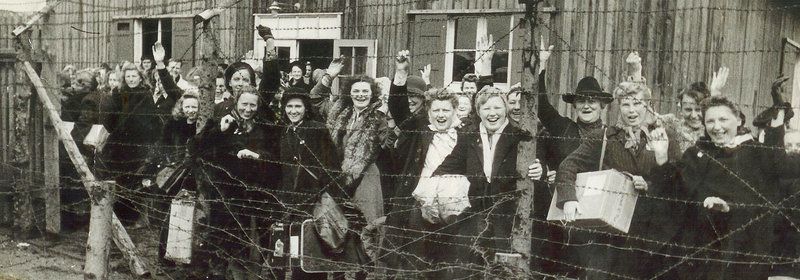Frøslevlejren - a visit back in time
Frøslevlejren - Frøslev camp - was built as a German internment camp in 1944 during the German occupation of Denmark and is today one of Europe’s best preserved German prison camps.
Frøslevlejren 1944-1945
From the fall of 1943, the occupying power deported more and more Danes to German prison camps - despite protests from the Danish Government. During negotiations with the German occupying power in 1944, the Danish government suggested to build an internment camp on Danish soil to prevent, more Danes were deported to other countries. Several thousand Danes were in the camp as Germany’s prisoners.
Even though the camp was built to prevent the deportation of Danish prisoners to the German concentration camps, around 1.600 prisoners from Frøslevlejren - against all agreements - were deported to the terrifying concentration camps around Germany.
Fårhuslejren 1945-1949
Immediately after the German capitulation on May 5, 1945, Frøslevlejren was emptied for prisoners - just to be filled with new ones immediately after that. There was an immediate need for interment possibilities for the many Danes, who were accused of treason by the resistance movement. The many barracks in Frøslevlejren were useful for this - and the camp was renamed Fårhuslejren and were used for the traitors or snitches, as they were also called. Fårhuslejren became the largest prison for traitors in Denmark.
About 5.000 people were imprisoned in Fårhuslejren in the period from the liberation of Denmark until the camp was shut down in October 1949. Most of the prisoners came from the German minority in Southern Jutland - around 3.000 persons. Fårhuslejren was shut down in 1949, as most of the traitors had endured their punishments.
Padborglejren 1949-1984
The Danish army took over the camp in November 1949. It was to be converted into barracks and was renamed Padborglejren. From 1968-1975 Padborglejren was used as barracks by the Danish Civilian Defense. After that, the camp was used as a depot for hospital material for the defense. Allegedly, the camp would have been demolished, if Frøslevlejren’s Museum had not been established in 1963.
Frøslevlejren 1984-today
In 1984, the County of Southern Jutland and Bov Commune formed - The Self Owning Institution Frøslevlejren. The purpose was to renovate the buildings in the camp and preserve it as a historical memorial from World War II. The Danish State, which via a department owned the camp area, gave “The Self Owning Institution Frøslevlejren” the rights to use the area and the building - except Frøslevlejren’s Museum, which was owned by the Danish National Museum. “The Self Owning Institution Frøslevlejren” rented out the barracks for various schools, exhibitions, and companies. In 2004, The Union of Danish Export Haulers left the camp as the last renters.
In 1999, a bill was submitted in the Danish parliament to establish a national memorial park in Frøslevlejren. Overall, the bill suggested, the memorial park - beside Frøslevlejren’s Museum - only should be used for museum operations and other cultural events that can function in respect for the memorial park”. The bill was not voted through, but passed on to Cultural Affairs, who had to find a solution with political support.
The solution was found in 2001 after thorough discussions between all the involved parties.
1,5 million DKK was earmarked to establish a memorial park in the area. A lot of trees were cut down, the original paths were re-established, light masts and signs were changed with the originals, the old barbed wire fences and dismantled buildings marked in the terrain, and last, but not least, all parking places were dismantled and re-established outside the memorial.
Today, the original camp is more visible and marks the history of the camp from 1944-1945.
Frøslevlejren’s Museum
The regular exhibitions of the museum are found in the camps main guard tower and in one of the previous prisoner barracks. Both buildings are original from 1944. I the main guard tower, the exhibition tells about the political background for the building of the camp, the history of the buildings, the German surveillance and management of the camp and the Danish penitentiary’s role in the camp.
In the old prisoner barracks the exhibition displays the daily life in the camp for the prisoners. It also shows the conditions in the German concentration camps, where about 1.600 prisoners from Frøslevlejren were deported to.
In Frøslevlejren’s Museum, you have the possibility to book a tour or lecture about the history of Frøslevlejren. Both the tour and lecture have a duration of about 50 minutes.
Lesen Sie mehr auf: www.natmus.dk/museer-og-slotte/froeslevlejrens-museum/rundvisning-og-foredrag/

Gps: 54.842974, 9.328888
Bedste Bo - Gastgeberbeitrag
Genner Bugt und Aabenraa
Schloss Gråsten
Ribe - Mittelalter und Wikingerstadt
Immer ein Künstler - Thomas Eje und Katherine Scrivens
3 Sterne Erlebnisse in Sønderborg
Givskud Zoo
Aabenraa - HanneZzz BB - Gastgeberbeitrag
Bredebro - Marskgården BB - Gastgeberbeitrag
Kolding - Koldinghus
Jelling - ein Stück dänische Geschichte
Padborg - Frøslevlejren
Der Wattenmeer-Nationalpark - Weltklasse
Tønder - Eine Stadt im Marschland
Fredericia - Stadt für jedermann
Sønderborg - Dybbøl Mühle
Sønderborg - Ringreiterfestival
Südjütland - Dänemarks Tor zu Europa
Südjütland - Ein Windgetrocknet Fisch
Südjütland - Schwarz Sonne